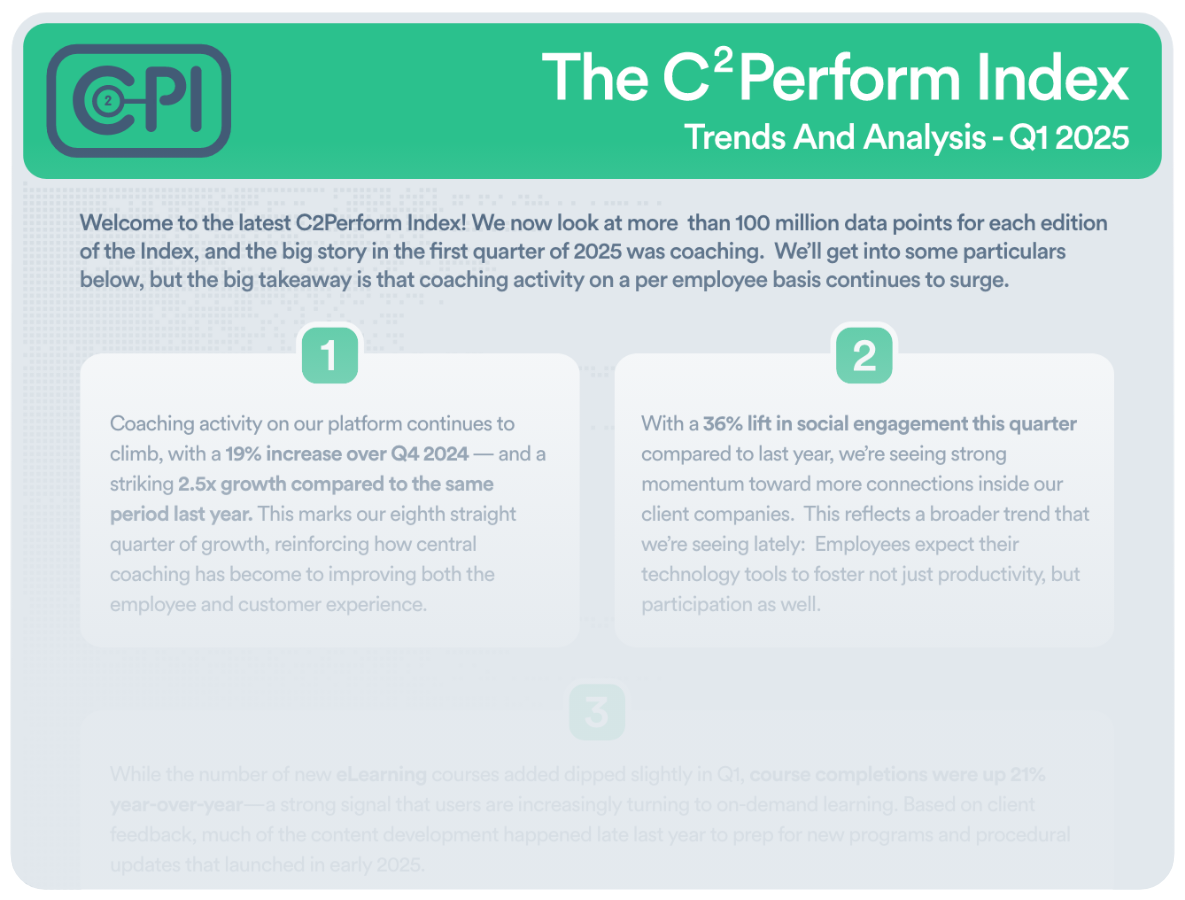An employee performance dashboard can be incredibly useful for getting an “at-a-glance” view of how your team is doing when it comes to meeting their performance goals (or, if you want, their process goals).
But, is taking the time and effort to set up an employee performance dashboard worth the benefits? The short answer is: “Yes!” The time and resources you invest into setting up an employee dashboard can be repaid several fold by the time saved and the performance improvements you can achieve when you have the ability to easily view how your team is performing.
Setting Up an Employee Performance Dashboard
There are a few different ways you can set up an employee performance dashboard. You could try to set up your own solution manually, use a pre-built dashboard software tool and integrate data sources via an application programming interface (API), or use an employee performance management platform with a built-in dashboard and performance tracking solution.
Let’s assess each of these options:
- Self-Setup (Fully Manual). One positive of doing everything yourself is that you have full control over the tool. Also, you don’t have to pay licensing fees for a premade software (aside from whatever software dev kit tools you use to build it, naturally). However, this requires a significant amount of time and effort to do. If you don’t have the programming skills to do it yourself, then you may need to hire a full-time team of software specialists to build, implement, and maintain the solution on your behalf—which can be even more expensive than simply licensing a third-party dashboard software.
- Using a Premade Dashboard with APIs. Here, you take whatever employee performance tracking solutions you’re currently using and interface them with a third-party dashboard app. The vendor handles the dashboard app setup and maintenance for you, so you don’t have to create a new solution from scratch—saving some time and effort for you and your organization’s IT team. The main difficulty is in managing the API and making sure there aren’t any issues that keep data from being sent to the dashboard. Also, different dashboard app providers offer varying levels of support for maintaining APIs—some just give you a software download and leave it up to you to integrate your data sources while others offer built-in integrations with certain data sources.
- Using an Employee Performance Platform with Built-In Dashboards. This is when you use a dashboard that is part of a larger employee performance management platform that already has tools for collecting performance data and forwarding it to the dashboard. This typically offers the greatest ease of use and management since there’s no need for a separate API and you can leave all maintenance and updates to the platform provider.
When setting up a dashboard, whether you build it yourself or use a premade solution, you’ll want to make sure that it will show you the metrics that are most important to your organization. For example, if you’re creating a dashboard for a call center focused on customer support, you’d probably want to emphasize metrics like tickets closed, average time-to-resolution, and/or total number of calls taken.
A contact center focused on sales activities would likely benefit more from tracking performance metrics like total sales, average sales value, and the number of outgoing calls made by each rep per shift.
It can also help to periodically change which metrics you track on the dashboard to align with specific company goals. For example, if your company launches an initiative to upsell a specific product or service to customers or achieve a 99% customer satisfaction rating, then you may want to push those metrics to your dashboard view.
Benefits of Employee Dashboards
What are the benefits of having an at-a-glance view of the performance of a single employee or a whole team? Having a well-constructed employee performance dashboard can help you in several ways, such as:
1. Improving Coaching Efforts
Employee coaching is critical to maintaining employee engagement and improving productivity. One of the biggest benefits of having an employee performance dashboard is that it puts each employee’s most important performance metrics at your fingertips in an easy-to-interpret format.
This can be invaluable for coaching sessions.
For example, you can use your dashboard to see which employees are performing the best, which ones are underperforming, and which ones are right in the middle of the pack. This helps you identify the employees who can benefit the most from a little guidance, which ones need immediate course correction, and which ones can be useful for a mentorship initiative. Armed with this information, you can make more efficient use of your time by focusing on the employees who need coaching the most.
After the coaching session is done, having a dashboard view of the employee’s performance can help you determine the session’s impact. For example, did the employee’s performance improve, get worse, or stay roughly the same? Are there any outliers among the team who showed more or less improvement after coaching?
This information can be useful for gauging the effectiveness of coaching sessions so you can improve them. It can also help you identify which employees respond well to coaching and which ones aren’t improving even with guidance. Users of C2Perform’s coaching and performance tracking tools have used this information to guide staffing decisions to optimize team performance.
2. Saving Time on Performance Tracking
Being able to get an “at-a-glance” view of employee performance without having to dig deep into different data analytics tools can be a major time-saver for busy managers—especially in call centers where a single supervisor might have to look after a dozen or more agents and keep track of their performance.
Instead of having to log into multiple performance tracking tools and manually collating data, a dashboard lets you open up the dashboard app, take a quick look at all of the metrics you’ve chosen to display there, and get on with your day. This can help save a lot of time on analyzing employee performance so you have more time to actually act on that information.
3. Improving Productivity and Performance
Having an objective view of their performance data can make a critical difference in how employees perform. Creating a shared dashboard view where employees can see how their results stack up against their peers can be immensely useful for driving some competitive spirit.
For example, say that Jack and Jill are two sales agents working in a call center. Each one performs better than average already as they’re both highly-motivated workers who want to be the best. One day, their manager introduces a public data dashboard where they can see which one of them is ahead in sales. Neither of them like to lose. So, each time that one pulls ahead of the other, they redouble their efforts to catch up or increase their lead.
This introduces a competitive element in their work that inspires both agents to improve. Also, other members of the sales team can see Jack and Jill’s results and know that their own goals are achievable. Encouraging others to imitate their strategies could help improve sales across the rest of the team.
4. Improving Decision-Making
One key benefit of being able to look at a whole team’s performance all at once is seeing if there are any trends in performance during a given period.
For example, say that, month-over-month or year-over-year, you see a drastic increase or reduction in productivity on your team. If the pattern is consistent for specific months of the year, that could be an indication that there’s a seasonal aspect to productivity which you might need to adjust for.
If there’s a large drop in results that is abnormal for the time of year, then it might be worth investigating the cause of the drop. For example, was there a major change to workplace policies/practices, team composition, or the work environment just before the drop? That could be an indicator of an issue that needs fixing.
With data in hand, you can identify these trends more reliably and start taking the appropriate measures to correct them. Having a convenient data dashboard that focuses on your most important metrics makes finding these patterns just a bit easier. This alone can make setting up a data dashboard easier.
Take Performance Management to the Next Level
Need help setting up a data dashboard? Make putting all of the data you need at your fingertips easy by reaching out to C2Perform! We provide a comprehensive employee performance management suite that combines data dashboards with employee performance tracking, coaching, communication, and more to give you all of the information you need in a single platform.
Save time and help your team be better every day with C2Perform.
 English
English Español
Español









